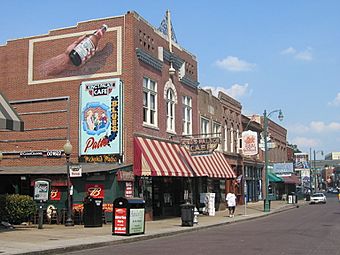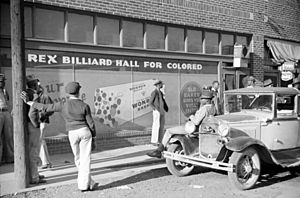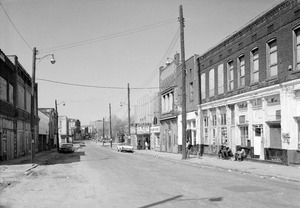Beale Street facts for kids
|
Beale Street Historic District
|
|

Beale Street, showing King’s Palace Cafe, Beale St. Tap Room, and Mr. Handy’s Blues Hall.
|
|
| Location | Memphis, Tennessee |
|---|---|
| Area | 27 acres (10.927 ha) |
| Built | 1900 |
| Architectural style | Late 19th and 20th century revivals, late 19th and early 20th century American movements |
| NRHP reference No. | 66000731 (original) 92001581 (increase) |
Quick facts for kids Significant dates |
|
| Added to NRHP | October 15, 1966 |
| Boundary increase | July 29, 1993 |
| Designated NHLD | May 23, 1966 |
Beale Street is a famous street in Memphis, Tennessee. It stretches about 1.8 miles (2.9 km) from the Mississippi River to East Street. This street is super important for Memphis history and for blues music. Today, Beale Street is full of fun blues clubs and restaurants. It's a big tourist spot in Memphis. Lots of festivals and outdoor concerts happen here, bringing huge crowds.
Contents
The Story of Beale Street

How It Started
Beale Street was created in 1841. A man named Robertson Topp planned it. He named it after a forgotten military hero. At first, it was called Beale Avenue.
The west end of the street had shops. Merchants traded goods with ships on the Mississippi River. The east end became a fancy neighborhood.
In the 1860s, many black musicians started playing on Beale Street. The first group to call it home was the Young Men's Brass Band. Sam Thomas started this band in 1867.
A Time of Change
In the 1870s, Memphis faced tough times. Several yellow fever outbreaks hit the city. Because of this, the city lost its official charter in 1879.
During this period, Robert Reed Church bought land near Beale Street. He later became the first black millionaire in the South. In 1890, Beale Street got a new look. The Grand Opera House was added, which is now the Orpheum.
In 1899, Robert Church paid the city to create Church Park. It was at the corner of 4th and Beale. This park became a place for fun and culture. Blues musicians often gathered there. The park had a large auditorium for 2,000 people. Famous speakers like Woodrow Wilson and Franklin D. Roosevelt spoke there.
Important Places and People
The Beale Street Baptist Church is also very important. It's the oldest African American church building in Tennessee. It played a big role in the early Civil Rights Movement in Memphis.
In 1889, Ida B. Wells was a co-owner and editor. She ran an anti-segregation newspaper called Memphis Free Speech. Her office was on Beale Street. Sadly, a white mob later destroyed her printing presses.
In the early 1900s, Beale Street was lively. It had many clubs, restaurants, and shops. Many of these businesses were owned by African-Americans.
The Birth of the Blues
In 1903, Mayor Thornton needed a music teacher. He wanted one for his Knights of Pythias Band. He asked his friend Booker T. Washington for help. Washington suggested a trumpet player named W. C. Handy. Handy lived in Clarksdale, Mississippi.
Mayor Thornton contacted Handy, and Handy moved to Memphis. He became known as the musician who created the "Blues on Beale Street." Mayor Thornton and his three sons even played in Handy's band!
In 1909, W. C. Handy wrote "Mr. Crump." It was a song for a local leader named E. H. Crump. This song was later renamed "The Memphis Blues." Handy also wrote "Beale Street Blues" in 1916. This song helped change the street's name from Beale Avenue to Beale Street.
From the 1920s to the 1940s, many blues and jazz legends played here. These included Louis Armstrong, Muddy Waters, Albert King, Memphis Minnie, B.B. King, Rufus Thomas, and Rosco Gordon. They helped create the unique sound known as Memphis blues. When he was young, B. B. King was called "the Beale Street Blues Boy."
One of Handy's students on Beale Street was Walter Furry Lewis. He later became a famous blues musician. In his later years, Lewis lived near Fourth and Beale. In 1969, a music producer recorded him in his apartment.
A Street of Firsts
In 1934, a community leader named George Washington Lee wrote a book. It was called Beale Street: Where the Blues Began. This was the first book by a black author to be advertised in the Book of the Month Club News.
In 1938, Lewis Ossie Swingler had an idea. He was the editor of the Memphis World Newspaper. To get more readers, he started a "Mayor of Beale St." contest. Readers voted for their favorite person. Matthew Thornton, Sr. won the contest. He was a well-known community leader. He was also a founding member of the Memphis Branch of the NAACP. Mr. Thornton became the first "Mayor of Beale St." This was an honorary title. He held it until he passed away in 1963.
Saving Beale Street
By the 1960s, Beale Street was struggling. Many businesses closed down. Even so, the part of the street from Main to 4th was named a National Historic Landmark in 1966. On December 15, 1977, the United States Congress officially called Beale Street the "Home of the Blues."
Despite this honor, Beale Street was almost empty. A big urban renewal plan had torn down many buildings nearby. Some buildings on Beale Street were also removed.
In 1973, the Beale Street Development Corporation (BSDC) was formed. George B. Miller and others created it. They wanted to bring Beale Street back to life. In 1978, the City of Memphis chose them. They would help redevelop the blocks between Second and Fourth streets. The BSDC worked hard to save the street's history. They also helped it grow culturally and physically. The BSDC got $5.2 million in grants to fix up Beale Street.
In 1982, the City of Memphis suggested that BSDC hire a management company. This company was led by John A. Elkington. They would help find new businesses. They would also collect rents and handle maintenance. Every new lease needed approval from BSDC, the City of Memphis, and the management company.
In October 2012, a court decided that the City of Memphis would manage Beale Street day-to-day. This happened after a long legal disagreement.
Music and Festivals
Every year, during the first weekend of May, a big event happens. It's called the Beale Street Music Festival. Major music artists from different styles come to play. The festival takes place at Tom Lee Park, at the end of Beale Street by the Mississippi River. This festival kicks off a month of fun events in Memphis called Memphis in May.
In 2020, the Beale Street Historic District was added to the U.S. Civil Rights Trail. The WDIA radio station in Memphis was also added.
Fun Things to See and Do
- Hard Rock Cafe (126 Beale)
- Blues City Cafe & the Band Box (138-142 Beale)
- Blues City General Store (144 Beale)
- B. B. King's Blues Club (143 Beale)
- Memphis Music (149 Beale)
- Club 152 (152 Beale)
- The Shadows - 3rd floor of Club 152 (152 Beale)
- Tater Red's (153 Beale)
- Miss Polly's Soul City Cafe (154 Beale)
- Alley Katz (156 Beale)
- King Jerry Lawler's Hall of Fame Bar & Grille (159 Beale)
- King's Palace Cafe (162 Beale)
- A. Schwab's (163 Beale)
- The Pig (167 Beale)
- Beale Street Tap Room (168 Beale)
- The Black Diamond (153 Beale)
- Johnny G's Creole Kitchen (156 Beale)
- Strange Cargo (172 Beale)
- Rum Boogie Café (182 Beale)
- Silky O'Sullivan's (183 Beale)
- FedExForum (191 Beale)
- Memphis Rock 'n' Soul Museum (191 Beale)
- Alfred's on Beale (197 Beale)
- Beale Street Blues Gifts (200 Beale)
- Dyer's Famous Hamburgers (205 Beale)
- People's Billiard Club (323 Beale)
- Historic Daisy Theatre (329 Beale)
- The New Daisy Theatre (330 Beale)
- The Lange Place
- Mr. Handy's Blues Hall
- Eel Etc. Fashions (333 Beale)
- Withers Collection Museum and Gallery (333 Beale)
- Jerry Lee Lewis' Cafe and Honky Tonk (310 Beale)
- Lil Anthony's Cafe (341 Beale)
- W.C. Handy historic home (352 Beale)
- Red Rooster (340 Beale)
- The Beale Street Flippers





